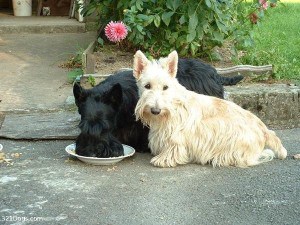Scottish Terriers are a relatively easy breed to groom and to keep looking neat and trim.
Because they are a low shedding breed, the grooming routine is necessary to keep both the long outer hair and the soft inner hair tangle and mat free, rather than to remove excess hair that is being shed.
If grooming is done on a daily basis, it becomes a short procedure that is relatively quick and easy.
Grooming your Scottish Terrier can be done differently depending whether you are grooming for ease of care or grooming to show.
A Scottie that is not being shown can be trimmed to any length, depending on the personal preference of the owner.
Many Scottie owners trim the dog close to the body to prevent twigs, grass, dirt and other objects from being caught in the long body hairs, especially if the dog enjoys outside activities.
This can be done at home or by a professional groomer.
A pin brush can be used to daily to bush out any tangles or mats. A coarse toothed comb should then be used to get even small knots out. Pay particular attention to the long hairs on the belly and behind the front legs, as this is often where the worse matting occurs.
Hair on the face and the beard should be brushed forward, and can be trimmed to keep it manageable. If your dog is slightly dirty or doggy smelling, a quality pet dry cleaner can be sprinkled on the coat and brushed through to help the process.
BATHING
Bath a Scottie only when necessary, and avoid over bathing as this will soften the outer coat, and can increase the amount of mats and knots in the hair.
Use only good quality dog shampoo and conditioners, and be very scrupulous in drying the dog completely after a bath. This is best done with a pet hair dryer, and brushing and blow-drying against the direction of hair growth.
Once the hair is completely dry, especially make sure the hair next to the skin is also dry; you brush the hair back with the direction of growth.
NAILS
Bathing is a good time to check your Scottie’s nails. They are known for their strong and sturdy nails, so a good set of guillotine style clippers work best. Make sure the blade is sharp to avoid splintering the nail.
Only remove the very tip of the nail to avoid cutting into the quick. This is very painful for the dog, and the quick will bleed profusely. If you are in doubt of where to clip the claws, have a professional groomer or vet complete the process.
CLIPPING
Clipping your Scottie can be done at home, provided that you have the correct equipment. It is important to make sure that the blades of the clippers are as sharp as possible, and that the dog is as clean as possible.
The best time to clip a Scottie is immediately after a bath, as this prevents the coarse or dirty hair from dulling the blades.
Most groomers recommend electric animal clippers and a #10 blade. The hair should be left longer on the body, legs, beard and eyebrows, and shorter over the rest of the animal. Care should be taken to clip the coat only in the direction of hair growth.
Take small, overlapping strokes, and follow the natural contour of the dog. Use scissors to trim and shape the hair after clipping if necessary.
Don’t use clippers around the eyes or other sensitive areas, as the dog will become leery of the process if they are hurt or accidentally nicked. Take your time, and remember that the dog may be getting tired out as well.
Make the process positive, and always remember to give lots of praise and pats to the Scottie during the clipping.
Many owners prefer to take their Scottie to a groomer once every few months for a trim. This is often easier, and groomers can do the dog’s nails as well as emptying anal glands at the same time.
STRIPPING
If you are showing your Scottie, you should never trim their coat. Trimming can lead to a softening of the hair, and this can be a faul in the show ring. For show purposes the process of stripping is used.
This involves the hair being brushed against the direction of growth, and then the long hair being plucked out in the direction of growth. The natural contours of the dog are maintained, and the coat actually looks very natural when stripped.
This process should only be done by someone familiar with how to strip a dog. Many groomers and breeders are willing to show owners the process if they would like to learn.
Several classes are available from professional groomers, to teach dog owners how to correctly prepare their breed for the show ring.
EYES AND EARS
Both the eyes and ears of the Scottie should be gently cleansed with a warm damp cloth or cotton ball, on a weekly basis. If the dog is very active or is outdoors a lot, this may need to occur more regularly.
Not prone to tearing, the Scottie does not usually have problems with staining on the face. A vet should examine any excessive or constant tearing at the earliest possible time.

